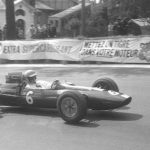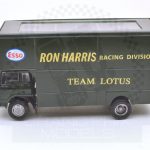LOTUS’ JUNIOR SQUAD – RON HARRIS TEAM LOTUS – by STEVE HOLE
During the sixties, one of the characters involved in Britain’s motorsport scene was a chap called Ron Harris, running his own teams and also on behalf of Lotus and Lola in Formula Junior, Formula 3 and Formula 2. A total of 84 races with seven victories. STEVE HOLE charts the racing history of one of the paddock’s best-turned-out teams.

There have been a few famous Ron Harris’ over the years. There was Ron ‘Chopper’ Harris who played 655 games for Chelsea between 1960-1980 and then another 61 for Brentford, before retiring in 1983.
Then there was Ron ‘The con-rod father’ Harris, founder of Harris Performance Engines. He was the Ford engine builder par excellence from South London. He built his first engine aged just 14.
Ron became a legend in Ford tuning circles and was the head of a dynasty that now features his sons, Jeff, Andy, Martin and Ronnie and also one of his grandsons, James.
As well as the basic tuning work on stuff like Cortinas, Capris, Fiestas and Escorts, Ron did a nice line inserting 300bhp Ford V8s under the bonnets of Zephyrs and Zodiacs. A less heralded version of what Jeff Uren was doing at Raceprooved.
However, the Ron Harris, we’re concentrating on here is famous for being Ron Harris Team Lotus which in turn was part of ‘Ron Harris Racing Division’. He was born in Reading, Berkshire on Christmas Eve 1905.
An equally interesting character, Harris was born in Maidenhead in 1906 and was a keen motorcyclist, competing in the Isle of Man TT several times from 1931 until the outbreak of war.

Post-war he got into film distribution and became well-known for it. However, he also had a passion for motorsport, running his own Ron Harris Racing Division (a satellite of his film distribution company) race team from 1961 in the European Formula Junior championship with a pair of Lotus Type 20s for John Gee-Turner and Mike Ledbrook. The team did pretty well, although John Fenning replaced Ledbrook, halfway through that first season. His wife, Francoise was actively involved with his race team looking after admin duties.
In 1962, Ron entered his team in British Formula Junior with Fenning and Gee-Turner continuing in the team’s Lotus 20s. However, they came to the attention of Eric Broadley who was quietly establishing his Lola Cars operation. He offered Ron a chance to run his Lola FJ team in the French Formula Junior championship in 1962 with Fenning and John Rhodes doing the driving in Lola Mk5s, although this doesn’t appear to have gone further than one race outing and Harris was back concentrating on his Lotus’ thereafter.
In 1963, Ron Harris Racing Division was busy and pretty successful campaigning entries in European Formula Junior with Lotus 27s for John Fenning and Mike Spence.
The team – and Harris’ management skills – came to the attention of Colin Chapman of Lotus who asked Ron to take over his race activities outside of F1 so Ron Harris Racing Division became the Lotus semi-works team under the Ron Harris Team Lotus banner looking after European F3 an F2 campaigns from 1964.
The F3 squad used Lotus 35s for Peter Revson and Brian Hart who had moved up from Len Terry’s Terrier team, while in F2 drivers such as Spence, Fenning, Peter Arundell and John Cardwell were often joined by the likes of Jackie Stewart and Jim Clark in Lotus 32s.
Back in those days, you’d regular see F1 drivers taking part in F2, either on a day off or because they fancied doing a support race on a GP weekend.
Clark won seven F2 races in 1964 (and in 1965) taking the Autocar British F2 Championship title in 1964 and also the French equivalent, the Grand Prix de France title in the same year.
Ron ended his agreement with Chapman at the end of 1965 although the rebranded Ron Harris Racing Division was back for 1966 and busier than ever mainly in European F3 with selected races in UK non-championship rounds and the British series.
Driver strength was the omnipresent John Cardwell, with Frenchman, Eric Offenstadt and future F1 engine builder, Brian Hart although at various times John Hine, David Hobbs, Giacomo Russo, Rob Slotemaker and for one round, Swedish driver Freddy Kottulinsky (in a Lotus 35) ran under the Ron Harris flag.
If 1966 was a big year, then 1967 was even busier for Ron Harris. His team kicked off the year travelling to Argentina for the four-race Temporada F2 series which took place in January and February. A long way to go but lucrative for those that did make the trip as the start and prize money were generous.
Ron Harris-spec Lotus Type 35 and Type 41 were shipped to the South American country for John Cardwell, Eric Offenstadt and Giacomo Russo with Cardwell and Offenstadt finishing fifth and sixth respectively in the series that was won by Jean Pierre-Beltoise.
Back in the UK, the season would see Ron Harris Racing Division active in European F3 with Cardwell and Offenstadt turning out in pristine Lotus 41s.
Perhaps the biggest development was that Ron Harris became a manufacturer as he gave Frank Costin £20,000 (over £250,000 today, allowing for inflation) and four months to build him an F2 car for a tilt at the European Formula 2 Championship that started in late March 1967 at Snetterton.
Never one to shirk a challenge, Frank accepted and created one of his brilliant wooden monocoques which had some distinctive features like inboard suspension, unusual for 1967 and a full windscreen, which looked strange but was advanced for its time as it kept oil and debris away from the drivers’ faces. The car also had a nosecone that looked pretty similar to that of the Vanwall that Frank had previously designed.
The Protos 16, looking resplendent in Ron Harris Racing Division’s bright red livery was ready for the first race (Protos means ‘practicality’ or ‘real’, by the way) for Eric Offenstadt and Brian Hart. Pedro Rodriguez also drove a few races too and proved the strength of the monocoque when he had a monster accident at Enna that many people felt wasn’t possible to survive. Others to sample the RHRD Protos 16 were Kurt Ahrens Jr and Rob Slotemaker.
Frank was frustrated that there wasn’t more money available for development and testing and although incredibly quick in a straight line (Brian Hart held the lap record at Hockenheim for two years in a Protos 16) it didn’t corner at all well.
Reliability was also an issue and Harris became very upset and withdrew his team from the championship in August following the Enna round in Sicily (Hart finished eighth). Although the Protos experience ended badly and cost a lot of money, Harris and Costin remained good friends.
Little did Ron Harris know that 1968 would be his last season running his own motorsport team. As usual, Harris had made good preparations at his Surbiton, Surrey HQ and had done a deal with Italian brothers and co-founders of the Tecno marque Luca and Gianfranco Pederzani.
They had made their fortunes producing hydraulic pumps before making their own karts from 1961. They would win the world championship four times between 1963-1966 and evolved into producing cars for Formula B, Formula 3 and Formula 2 (they later entered F1 under the Martini Racing name).
Ron Harris ordered a pair of their very dominant TF68 F3 car and two of their PA68 F2 car. However, the Tecno F2 wasn’t ready for the early races and they rolled out a revised Protos 16 and then a BRM P216 Special before the PA68s were ready in May.
The F3 team drivers for 1968 were Eric Offenstadt and new recruit, another French driver, Philippe Vidal although the cars didn’t prove very successful and Ron withdrew his team in early May to concentrate on his F2 team. The Ron Harris Racing Division F2 driver strength featured – at various times – Offenstadt, Pedro Rodriguez, Vic Elford, David Hobbs, Richard Attwood and Jonathan Williams.
At least F2 had been slightly more encouraging but wasn’t one of the team’s best. However, plans were made to enter the Temporada series in Argentina once more, which in 1968 took place in December.
Harris shipped his Tecno PA68 F2 cars to Argentina, but things had got off to a poor start when two of his Cosworth FVA engines and three Hewland gearboxes were stolen while going through customs in Buenos Aires airport.
During the Temporada series (crowds were said to be ‘hostile’ at all rounds) Ron Harris Racing fielded Carlos Marincovitch, Oscar Mauricio Franco, Pedro Rodriguez and Carlos Reutemann.
Following the final round at Buenos Aires on December 22, when all three RHRD cars failed to finish the team was packing up their pit garage for the journey home to England poor Ron had an accident and somehow fell into the River Plate and injured himself quite badly although refused to go to the hospital.
This was the final straw for Ron who was deeply upset at the loss of his engines and gearboxes and with resources stretched after expenditure on the ill-fated Protos 16 project he cased all motorsport activities.
He continued to be involved in the film industry but suffered from ill health until his death, aged 69 on September 18, 1975, in Westminster.











